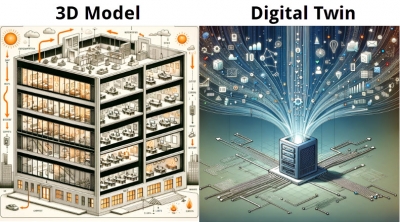Digital Twin
A "Digital Twin" is like a virtual model or copy of a real-world building, created on a computer. This model is designed to exactly mirror the physical building in every way that affects energy use, such as its size, shape, materials, insulation, windows, and how it's used by people.
The purpose of a digital twin is to simulate or predict how the building uses energy under different conditions. For example, it can show how much energy the building will use for heating or cooling throughout the year, how changing the type of windows or insulation might improve energy efficiency, or how installing solar panels could impact energy costs.

Creating a digital twin for a building energy simulation involves several steps. First, detailed information about the physical building is collected, including architectural drawings, material specifications, and systems layouts (such as HVAC, lighting, and plumbing). This data is then used to build a detailed 3D model of the building in specialized simulation software. The model is enriched with additional information, such as the building's geographical location, orientation, local climate data, and typical usage patterns (like occupancy schedules, appliance use, and lighting requirements). Advanced algorithms simulate the building's energy performance by taking into account how all these factors interact with each other. Sensors installed in the actual building can also feed real-time data into the digital twin, allowing the model to be continuously updated and refined to reflect current conditions accurately. This process ensures that the digital twin is a dynamic and precise representation of the real-world building, capable of predicting its energy performance with a high degree of accuracy.
By using a digital twin, architects, engineers, and building managers can make informed decisions on how to design, operate, or retrofit buildings to be more energy-efficient, sustainable, and comfortable for the people using them. It's like having a highly accurate video game version of a building to test out all sorts of scenarios before spending money and resources in the real world.